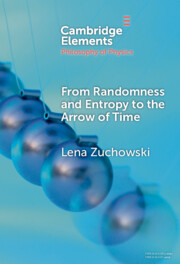Refine search
Actions for selected content:
4 results
2 - Thermodynamics with and without Irreversibility
- from Part I - Local Systems
-
-
- Book:
- The Arrow of Time
- Published online:
- 28 October 2025
- Print publication:
- 30 October 2025, pp 12-55
-
- Chapter
- Export citation
3 - Processes, First and Second Laws
-
- Book:
- Stochastic Thermodynamics
- Published online:
- 09 June 2025
- Print publication:
- 19 June 2025, pp 38-59
-
- Chapter
- Export citation

From Randomness and Entropy to the Arrow of Time
-
- Published online:
- 16 February 2024
- Print publication:
- 14 March 2024
-
- Element
- Export citation
7 - Thermodynamics
-
- Book:
- The Failures of Mathematical Anti-Evolutionism
- Published online:
- 28 April 2022
- Print publication:
- 12 May 2022, pp 221-266
-
- Chapter
- Export citation
